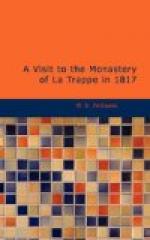I set out with the guide just at day-break, mounted on a small Norman horse, and armed with pistols and a sword-cane, in case of meeting with wolves, which the mayor of Solignie had cautioned me against, as abounding throughout the country. We travelled, after leaving the main road, at the distance of a league, through a country scarcely appearing to be inhabited. Here and there a lone cot, a mere speck, met the eye amidst a landscape composed of nothing but barren wastes and thick forests, nearly impervious to the light. We had penetrated about half a mile through one of the latter, my attention occupied with the romantic wildness of the scene, when we were alarmed by the howling of a wolf. My guide crossed himself, and began cracking his whip with the noise and singular dexterity peculiar to the French postillions; and as we entered a part of the forest, impenetrable but for traces known only to those who are accustomed to them, he related (by way of consolation, I suppose,) several stories of the peasantry having been recently attacked, and some destroyed, by wolves; and one instance of a woman having had her infant torn from her arms, only a short time since, in the neighbourhood.
On quitting the forest the track was now and then diversified by the ruins of a solitary cottage, or the mouldering remains of a crucifix, raised by pious hands to mark some event, or to guide the traveller; and after traversing a rocky plain, covered with heath and wild thyme, where some herds of sheep and goats were browsing, attended by the shepherd, we entered the Forest of Bellegarde. This forest spreads over a large extent of country, and is so dark and intricate, that those best acquainted with it frequently lose their way. No vestige of human footsteps or of the track of animals appeared; a mark, here and there, on some of the trees, was the only direction! Pursuing our way through turnings and windings the most perplexing, we found ourselves to be on the overhanging brow of a hill, the descent of which was so precipitous, that we were under the necessity of dismounting; and by a winding path, hollowed out in its side, descended through a sort of labyrinth towards the valley, whose sides were clothed with lofty woods, rising one above the other. The valley itself is interspersed with three lakes, connected with each other, and forming a sort of moat around the ground; in the centre of which appears the venerable abbey of La Trappe, with its dark gray towers, the deep tone of whose bell had previously announced to us, that we had nearly reached our journey’s end.
The situation of this monastery was well adapted to the founder’s views, and to suggest the name it originally received of La Trappe, from the intricacy of the road which descends to it, and the difficulty of access or egress, which exists even to this day, though the woods have been very much thinned since the revolution. Perhaps there never was any thing in the whole universe better calculated to inspire




